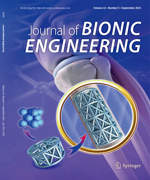The performance of bluespotted rays was emulated in the design of a bioinspired underwater propulsor in the present work. First, the movement of a live bluespotted ray was captured for the swimming mode and useful information to the biomimetic mechanism design. By virtue of the modular and reconfigurable design concept, an undulatory fin propulsion prototype was developed. With a proper experimental set-up, orthogonal experiments were conducted to investigate the effect of various fin design parameters on the propulsion speed, thrust, and power of the fish robot. The controllable fin parameters include frequency, amplitude, wavelength, fin shape, and undulatory mode. The significance of these parameters was also determined by using the variance analysis. The results demonstrate that the designed propulsor, imitating bluespotted rays with large expanded undulatory fins, is able to propel itself by changing various kinematic parameters.

 Table of Content
Table of Content
 Table of Content
Table of Content